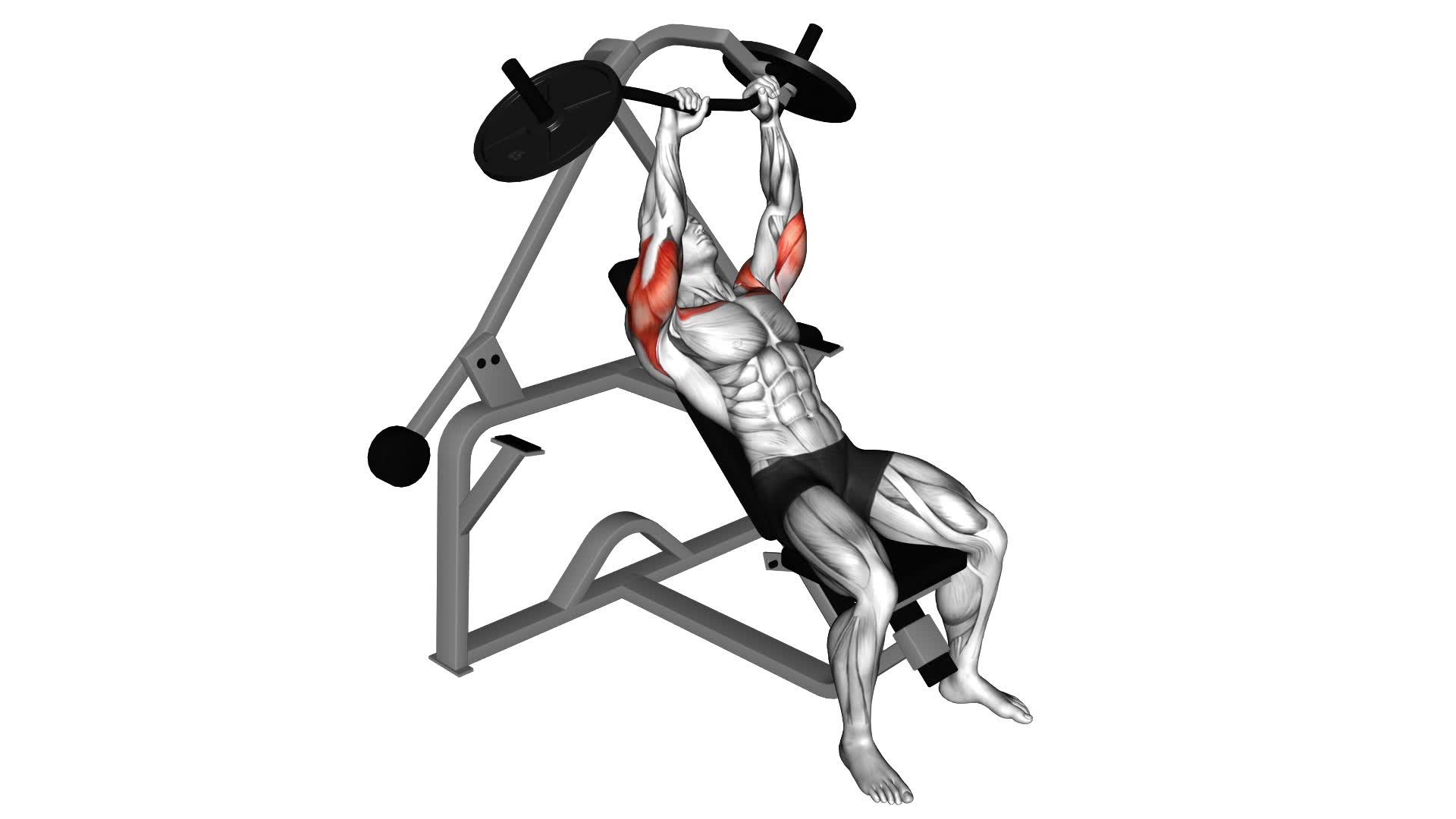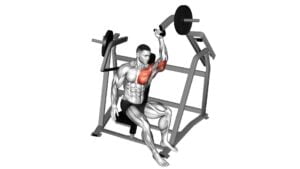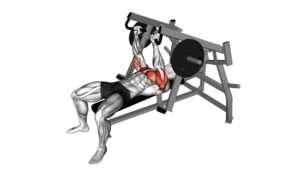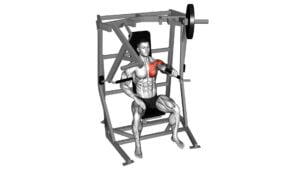Lever Incline Chest Press (Plate Loaded) – Video Exercise Guide & Tips

Are you looking to add more definition to your chest muscles?
Watch This Exercise Video
The Lever Incline Chest Press is a great exercise to target your upper chest and build strength.
In this video exercise guide, we'll show you the proper form and technique, variations to try, and common mistakes to avoid.
Plus, we'll share tips for increasing intensity and progression.
Get ready to take your chest workouts to the next level with this plate loaded exercise.
Key Takeaways
- Lever incline chest press is highly effective for improving upper body strength.
- Proper technique and form are important to prevent injuries and maximize results.
- Adjusting the incline angle and grip positions can target different areas of the chest.
- Gradually increasing the weight and incorporating other equipment options can increase intensity and progression.
Benefits of the Lever Incline Chest Press
You should regularly incorporate the Lever Incline Chest Press into your workout routine to maximize the benefits for your chest muscles. This exercise is highly effective for improving upper body strength and targeting specific chest muscles. The Lever Incline Chest Press is designed to specifically work the upper chest, shoulders, and triceps. By adjusting the incline of the bench, you can target different areas of your chest, allowing for a more well-rounded workout.
This exercise also engages the stabilizer muscles in your core and back, helping to improve overall stability and balance.
The Lever Incline Chest Press is a plate-loaded machine, which means you can easily adjust the weight to suit your individual strength and fitness level. This allows for progressive overload, which is essential for muscle growth and strength gains. By consistently challenging your muscles with heavier weights over time, you can continue to see improvements in your upper body strength.
To perform the Lever Incline Chest Press, start by sitting on the machine with your back flat against the bench. Grab the handles with an overhand grip, slightly wider than shoulder-width apart. Push the handles forward and upward until your arms are fully extended, then slowly bring them back down to the starting position. Remember to keep your core engaged and maintain proper form throughout the exercise.
Incorporating the Lever Incline Chest Press into your workout routine won't only improve your upper body strength but also help you target specific chest muscles for a more sculpted and defined chest.
Proper Form and Technique
To ensure proper form and technique during the Lever Incline Chest Press, it's important to pay attention to your shoulder positioning. Keep your shoulders back and down, engaging your chest muscles throughout the exercise.
Additionally, focus on your breathing technique, inhaling as you lower the weight and exhaling as you push it back up.
Shoulder Positioning During
Maintain proper shoulder positioning during the lever incline chest press exercise to optimize your form and technique. Here are some important tips to ensure proper alignment and maximize muscle activation:
- Keep your shoulders back and down throughout the entire movement. This helps engage the chest muscles and prevents unnecessary strain on the shoulders.
- Avoid shrugging or hunching your shoulders. This can lead to poor form and reduce the effectiveness of the exercise.
- Maintain a slight bend in your elbows. Fully extending your arms can put excessive stress on the shoulder joints.
- Focus on engaging your chest muscles by squeezing them together at the top of the movement. This helps to achieve a stronger contraction and better results.
Breathing Technique for
Breathe deeply and exhale as you push the weight away during the lever incline chest press, ensuring proper form and technique. Proper breathing patterns are essential for maximizing your performance and preventing injury during this exercise.
As you lower the weight towards your chest, inhale deeply, filling your lungs with air. This helps to stabilize your core and provide support for your upper body.
As you push the weight away, exhale forcefully, contracting your abdominal muscles and engaging your chest muscles. This exhalation helps to generate power and maintain control throughout the movement.
Remember to maintain a steady breathing rhythm and avoid holding your breath, as this can raise your blood pressure and decrease your overall performance.
Variations of the Exercise
- Wide grip: Place your hands wider than shoulder-width apart on the handles to focus more on the outer chest muscles.
- Narrow grip: Bring your hands closer together on the handles to emphasize the inner chest muscles.
- Neutral grip: Use a grip where your palms face each other, which can engage the triceps more while still targeting the chest.
- Reverse grip: Flip your hands so that your palms face up, which can activate the upper chest muscles and provide a different challenge.
By experimenting with these grip positions, you can work different angles of your chest and stimulate different muscle fibers.
It's important to note that the Lever Incline Chest Press can be performed using various equipment options such as machine-based lever press or lever press with free weights. These variations can help you prevent plateaus and keep your workouts interesting.
Now that you know about the different grip positions and equipment options, let's move on to the next section where we'll discuss common mistakes to avoid in the Lever Incline Chest Press.
Common Mistakes to Avoid
To ensure proper form and maximize your results, it's crucial to avoid common mistakes when performing the Lever Incline Chest Press. By paying attention to key pointers for proper execution, you can improve the effectiveness of this exercise.
One common mistake to avoid is using too much weight. It's important to start with a weight that you can handle comfortably and gradually increase it as you get stronger. Using excessive weight can compromise your form and increase the risk of injury.
Another mistake is failing to maintain proper posture. Make sure to keep your back flat against the bench and your feet firmly planted on the ground. Avoid arching your back or lifting your feet during the exercise, as this can put unnecessary strain on your lower back.
Additionally, avoid rushing through the exercise. Slow and controlled movements are essential for targeting the chest muscles effectively. Take your time to fully extend your arms and squeeze your chest muscles at the top of the movement.
Lastly, don't forget to breathe properly. Exhale as you push the weight away from your body and inhale as you bring it back in.
Tips for Increasing Intensity and Progression
To increase the intensity and progression of your Lever Incline Chest Press, focus on gradually increasing the weight and challenging yourself with each workout. Here are some tips to help you achieve that:
- Increase the resistance: As you get stronger, it's important to continually add weight to the machine. This will ensure that your muscles are constantly being challenged and stimulated for growth.
- Proper warm up techniques: Before starting your Lever Incline Chest Press, make sure to warm up your chest, shoulders, and arms with dynamic stretches or light cardio exercises. This will increase blood flow to the muscles and help prevent injuries.
- Vary your grip: Experiment with different grip positions on the handles of the machine. Changing your grip can target different areas of your chest, leading to more balanced muscle development.
- Incorporate supersets or drop sets: To further increase the intensity of your workout, try incorporating supersets or drop sets. This involves performing a set of Lever Incline Chest Press followed immediately by another exercise targeting the same muscle group, or reducing the weight after reaching fatigue to continue the set. This technique will push your muscles to their limits and promote muscle growth.
Safety Precautions and Modifications
To ensure your safety and make necessary modifications, follow these guidelines when performing the Lever Incline Chest Press exercise.
Safety modifications are crucial to prevent injuries and optimize your workout experience. Firstly, always warm up before starting any exercise routine to prepare your muscles for the upcoming workout.
It's important to maintain proper form and technique throughout the exercise. Keep your back flat against the bench and engage your core to provide stability. To avoid strain or overextension, don't lock your elbows at the top of the movement.
Additionally, start with a weight that's appropriate for your fitness level and gradually increase as you progress. Equipment recommendations include using a spotter when lifting heavier weights to ensure safety and assistance if needed.
Lastly, listen to your body and stop immediately if you experience any pain or discomfort.
Frequently Asked Questions
What Is the Recommended Weight Range for the Lever Incline Chest Press?
The lever incline chest press is a great exercise for building upper body strength and shoulder stability.
When it comes to the recommended weight range for this exercise, it's important to start with a weight that challenges you but still allows you to maintain proper form.
Gradually increase the weight as you get stronger, but always prioritize maintaining shoulder stability throughout the movement.
Can the Lever Incline Chest Press Help Improve Shoulder Stability?
The lever incline chest press can definitely help improve your shoulder stability. By targeting the muscles in your chest, shoulders, and triceps, this exercise strengthens the surrounding muscles that support your shoulder joint.
This increased stability can help prevent injuries and improve your overall upper body strength. Additionally, if you have shoulder injuries, there are variations of the lever incline chest press that can be performed to accommodate and rehabilitate these injuries.
How Often Should I Perform the Lever Incline Chest Press for Optimal Results?
To achieve optimal results from the lever incline chest press, it's important to consider the frequency and duration of your training.
The lever incline chest press can be performed 2-3 times per week, allowing for adequate rest and recovery between sessions.
Aim for a training duration of 45-60 minutes, focusing on proper form and gradually increasing the weight over time.
Consistency and progressive overload will help you see improvements in your chest strength and muscle development.
Are There Any Specific Warm-Up Exercises I Should Do Before Performing the Lever Incline Chest Press?
Before performing the lever incline chest press, it's important to do specific warm-up exercises to prepare your body. This will help prevent injury and improve your performance.
Some recommended warm-up exercises include shoulder stability exercises, such as shoulder rotations and band pull-aparts. These exercises will activate your shoulder muscles and increase blood flow to the area, preparing your body for the lever incline chest press.
Remember to start with lighter weights and gradually increase the load as you warm up.
Can the Lever Incline Chest Press Be Adapted for Individuals With Shoulder or Wrist Injuries?
If you have a shoulder injury, you can modify the lever incline chest press by using lighter weights and focusing on proper form. Keep your elbows at a comfortable angle and avoid any movements that cause pain.
For wrist injuries, you can modify the exercise by using wrist wraps or wearing gloves for added support. Make sure to listen to your body and consult with a healthcare professional before attempting any modifications.
Conclusion
In conclusion, the lever incline chest press is a highly effective exercise for targeting the chest muscles. By using proper form and technique, variations of the exercise can be incorporated to challenge different muscle groups.
It's important to avoid common mistakes and follow safety precautions to prevent injuries. By gradually increasing intensity and progression, individuals can continue to challenge themselves and see improvements in their strength and muscle development.

Author
Years ago, the spark of my life’s passion ignited in my mind the moment I stepped into the local gym for the first time. The inaugural bead of perspiration, the initial endeavor, the very first surge of endorphins, and a sense of pride that washed over me post-workout marked the beginning of my deep-seated interest in strength sports, fitness, and sports nutrition. This very curiosity blossomed rapidly into a profound fascination, propelling me to earn a Master’s degree in Physical Education from the Academy of Physical Education in Krakow, followed by a Sports Manager diploma from the Jagiellonian University. My journey of growth led me to gain more specialized qualifications, such as being a certified personal trainer with a focus on sports dietetics, a lifeguard, and an instructor for wellness and corrective gymnastics. Theoretical knowledge paired seamlessly with practical experience, reinforcing my belief that the transformation of individuals under my guidance was also a reflection of my personal growth. This belief holds true even today. Each day, I strive to push the boundaries and explore new realms. These realms gently elevate me to greater heights. The unique combination of passion for my field and the continuous quest for growth fuels my drive to break new ground.







